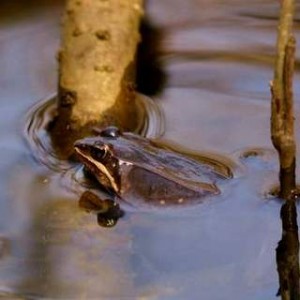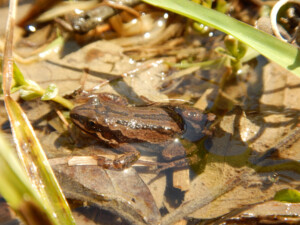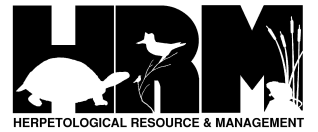Wood Frog
Overview:
Scientific Name: Rana sylvatica
Size: 1.4 – 3.3”
Status: Can be abundant in suitable areas.

Habitat:
Moist woodlands, including deciduous, coniferous, and mixed forests. Adults mainly terrestrial except during breeding season. Usually prefer closed canopy areas.
Adult Coloration:
Brown, grayish brown, bronze, reddish, or tan background color, with a dark brown or blackish “mask” extending from the eye through the tympanum (circular “ear” structure) to the shoulder, bordered by a white stripe on the upper lip. The mask extends forward in a narrower line to the tip of the snout. Males may appear nearly black and mask may be obscured during breeding. Can have black spots along each dorsolateral fold (ridge of raised skin down each each side of the back), on sides, and dark bands on hind legs. Belly is white, occasionally with gray mottling, sometimes with yellowish tint to sides or groin. In northern range may have light stripe on back and hind legs.
Adult Characteristics:
Dorsolateral folds extend from eye down back. In males, webbing between hind toes has a straight or outward curving edge. During breeding, not only do males often darken, but they also develop thickened thumbs and paired vocal sacs evident as skin folds between the jaw and shoulder on each side. Webbing between hind toes curves inward in the larger, lighter females. Voice: Series of clucks. Chorus may sound like ducks when heard from a distance. Produce chirp-like “release” call when inadvertently grasped by another male. e.g., http://www.youtube.com/watch?v=3Ah_slM_F34
Larvae Characteristics:
adpole can grow to 1.8” prior to development. Plump with short, high tail fin. Body is brown or olive, usually with black and gold specks. Tail is lighter, occasionally with black spots. Belly is iridescent white or bronze, with intestinal coil visible through skin.
Species Confused With:
Chorus frogs have similar mask-like pigmentation with a light lip stripe, but are substantially smaller, lack dorsolateral folds, and have expanded toe pads.

References:
- Amphibians and Reptiles of the Great Lakes Region by Jim Harding
- Harding, J.H. and J.A. Holman. 1992. Michigan Frogs, Toads, and Salamanders. MSU Cooperative Extension Service and MSU Museum. Extension Bull. E-2350, 144 pp.
- Ruthven, A. G., H. B. T. Gaige, et al. 1912. The herpetology of Michigan, by Alexander B. Ruthven. Crystal Thompson and Helen Thompson; Memoranda towards a bibliography of the archaeology of Michigan, by Harlan I. Smith; prepared under the direction of Alexander G. Ruthven. Lansing, Mich., Wynkoop Hallenbeck Crawford, State Printers.
- Holman, J. A. 2012. The Amphibians and Reptiles of Michigan: A Quaternary and Recent Faunal Adventure. Detroit, Mich., Wayne State University Press.
- Conant, R., and Collins, J. T. 1998. Reptiles and Amphibians: Eastern, Central North America. Houghton Mifflin Harcourt Press.
